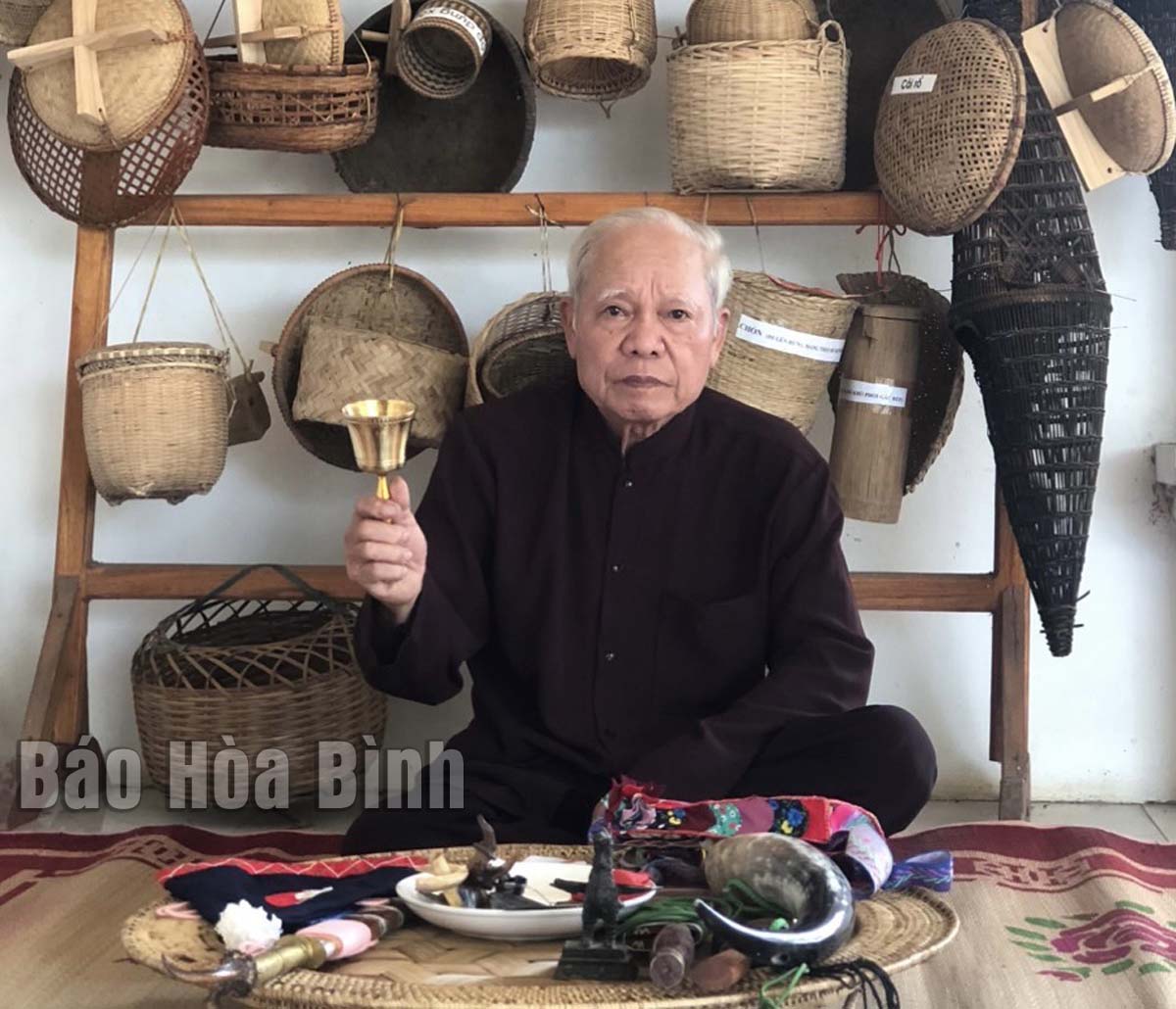
(HBO) – Established in 2021, Mo Muong Thang Club in Cao Phong district has made great contributions to preserving and promoting the values of Mo Muong, a unique cultural heritage of the Muong ethnic minority group in Hoa Binh province.
Artisan Bui Ngoc Thuan, Head of the Mo Muong Thang Club, checks necessary equipment for a Mo performance.
Mo Muong is a job and also a performance practiced at funerals, religious festivals, and life cycle rituals by the Muong ethnic group. The art consists of Mo prayers and performances, by Mo practitioners, or Mo artisans. Through generations, Mo prayers have been passed down verbally in the community. When they are collected, translated, and published in books, however, they begin to exist separately from people.
These days, most Mo prayers are called Mo Muong. They are a collection of verses recited at traditional Muong funerals. Each Muong community has its own version of Mo, but they are all fairly similar. The existence of various versions of Mo has helped expand the heritage and spiritual life of the Muong people.
Mo Muong has a long life, spanning centuries, as it has always helped to nurture the characteristics and the souls of the Muong people. It is the essence of labour, production, cultural behaviour and the philosophy of the Muong people, reflecting their love of life and home villages.
Mo Muong has been practiced in the northern mountainous provinces of Hoa Binh, Son La, Phu Tho, and Ninh Binh, the north central province of Thanh Hoa, the Central Highlands province of Dak Lak and Hanoi. Each meeting of the Mo Muong Thang Club gathers many Mo lovers who exchange experience in Mo practices.
At the meetings, young and old Mo artisans shared their skills and experience in performing Mo. Artisan Bui Ngoc Thuan, head of the club, said that the club was formed in late 2021 with 25 members from nine communes in the district. The club has made positive contributions to preserving and promoting the cultural heritage.
After two years of operations, the Mo Muong Thanh Club has drawn 46 members, including 16 young Mo practitioners aging from 26-45. Bui Yen Minh, Vice Director of the Division of Culture and Information of Cao Phong, said that the district is designing a project to build a Mo Muong heritage space in combination with tourism development in Hop Phong commune.
Along with supporting the promotion of Mo Muong culture, Cao Phong has introduced the heritage to local children in schools, thus contributing to maintaining and developing the unique values of Mo Muong./.
With an increasingly vibrant and widespread emulation movement aimed at building cultured residential areas and cultured families, Yen Thuy District has been making steady progress toward improving both the material and spiritual well-being of its people, while fostering a civilized, prosperous, beautiful, and progressive community.
Once lacking recreational spaces and community facilities, Residential Group 2 in Quynh Lam Ward (Hoa Binh City) has recently received attention for the construction of a new, spacious, and fully equipped cultural house. The project followed the model of state support combined with public contributions in both labor and funding.
The "All people unite to build cultural life" movement, which has been effectively integrated with Kim Boi district’s socio-economic development goals, is fostering a lively spirit of emulation across local residential areas, hamlets, villages, public agencies, and enterprises. In addition, through the initiative, traditional cultural values are being preserved and promoted, while community solidarity and mutual support in poverty reduction and economic development are being strengthened.
A working delegation of the Hoa Binh provincial People’s Committee led by its Permanent Vice Chairman Nguyen Van Toan on June 11 inspected the progress of a project to build the Mo Muong Cultural Heritage Conservation Space linked to tourism services in Hop Phong commune, Cao Phong district.
Born and growing in the heroic land of Muong Dong, Dinh Thi Kieu Dung, a resident in Bo town of Kim Boi district, in her childhood was nurtured by the sweet lullabies of her grandmother and mother. These melodies deeply imprinted on her soul, becoming an inseparable part of her love for her ethnic group's culture. For over 20 years, this love for her hometown has driven Dung to research, collect, and pass down the cultural values of the Muong people to future generations.
In the final days of May, the Ethnic Art Troupe of Hoa Binh Province organized performances to serve the people in remote, mountainous, and particularly disadvantaged areas within the province. These were not just ordinary artistic shows, but they were the meaningful journeys aimed at spreading cultural values, enhancing the spiritual life of the people and contributing to the preservation of ethnic minority cultural identities.



